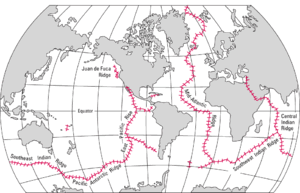East Pacific Rise

The East Pacific Rise is a mid-oceanic ridge, a divergent tectonic plate boundary located along the floor of the Pacific Ocean. It separates the Pacific Plate to the west from (north to south) the North American Plate, the Rivera Plate, the Cocos Plate, the Nazca Plate, and the Antarctic Plate. It runs from south from the Gulf of California in the Salton Sea basin in southern California to a point near 55° S, 130° W where it joins the Pacific-Antarctic Ridge trending west-southwest towards Antarctica near New Zealand (though in some uses the PAR is regarded as the southern section of the EPR). Much of the rise lies about 3200 km (2000 mi) off the South American coast and rises about 1,800–2,700 m (6,000–9,000 ft) above the surrounding seafloor.
Overview

The oceanic crust is moving away from the East Pacific Rise to either side. Near Easter Island the rate is over 15 cm (6") per year which is the fastest in the world but it is lower at about 6 cm (2.4") at the north end.[1][2] On the eastern side of the rise the eastward moving Cocos and Nazca plates meet the westward moving South American Plate and the North American Plate and are being subducted under them. The belt of volcanoes along the Andes and the arc of volcanoes through Central America and Mexico are the direct results of this collision. Due east of the Baja California Peninsula, the Rise is sometimes referred to as the Gulf of California Rift Zone. In this area, newly formed oceanic crust is intermingled with rifted continental crust originating from the North American Plate.
Near Easter Island, the East Pacific Rise meets the Chile Rise at the Easter Island and Juan Fernandez microplates, trending off to the east where it subducts under the South American Plate at the Peru–Chile Trench along the coast of southern Chile. The southern extension of the East Pacific Rise (called the Pacific-Antarctic Ridge) merges with the Southeast Indian Ridge at the Macquarie Triple Junction south of New Zealand.
Along the East Pacific Rise the hydrothermal vents called black smokers were first discovered and have been extensively studied. These vents are forming volcanogenic massive sulfide ore deposits on the ocean floor.[3] Many strange deep-water creatures have been found here. The southern stretch of the East Pacific Rise is one of the fastest-spreading sections of the Earth's mid-ocean ridge system.
References
- ↑ "Understanding plate motions", USGS. Retrieved 26 June 2013.
- ↑
- ↑ Herzig, P. M.; Petersen, S.; Hannington, M. D. (2000), Polymetallic Massive Sulphide Deposits at the Modern Seafloor and their Resource Potential (PDF), ISA Technical Study: No. 2, International Seabed Authority, p. 8
External links
- East Pacific Rise 2004 – Scripps Institution of Oceanography
- Columbia University Researchers Find Key to the Formation of New Seafloor Spreading Centers – Columbia University
